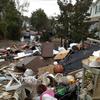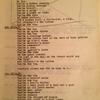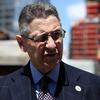Andrea Bernstein appears in the following:
Cuomo: Subway Trains Could Roll in 4-5 Tunnel Soon
Friday, November 02, 2012
Previous Work on the 4-5 Line at Borough Hall, Brooklyn (MTA Photo)
Governor Cuomo says the 4-5 train could be running under the East River soon. At a news briefing on Friday morning, Cuomo said: "We spoke with Kevin Burke in Con-Ed this morning, he's been making good progress especially in downtown Manhattan, he believes the power is going to be back on in what's called the Joralemon tunnel, which will facilitate the MTA bringing power back into the subway system in that area."
On Thursday, MTA Chief Joe Lhota said once power was on, subways could run on the F and 4/5 lines within two hours.
On Friday, Cuomo said he expects an announcement this afternoon.
"If Con-Ed is correct and they re-power downtown Manhattan, and if the Joralemon tunnel is correct you'll see more trains coming on line and we'll have that announcement later today as we see exactly the effect of the re-powering," Cuomo said.
An hour later, Mayor Michael Bloomberg said he'd hoped mass transit would be close to normal "soon."
Subway Flooding Predicted, Eerily Matches Climate Change Model
Thursday, November 01, 2012
The subway map after flooding in 7 tunnels and a power outage suspended service to much of Manhattan in the wake of Hurricane Sandy, Nov 1, 2012
Compare that map with this one we posted a year ago after Hurricane Irene gave us a taste of what water could do to a transit system.
With Sea Level Rise, Subways Flood in 40 Minutes During Intense Storms (Map Courtesy LDEO & Civil Engineering, Columbia University)
Four days after Hurricane Sandy slammed New York, a huge chunk of New York’s subway remains closed. Experts say the cost to the economy could run to the hundreds of millions.
Turns out they say the threat of rising sea levels coupled with big storms like Sandy’s to the city’s subway system – and its economy – was both predicted and predictable under models of rising sea levels.
New York’s Governor, Andrew Cuomo says New York has to rebuild its subway system to make it less vulnerable to storms like Irene and Sandy, which hit New York just fourteen months apart. “Part of learning from this is the recognition that climate change is a reality, extreme weather is a reality, it is a reality that we are vulnerable,” Cuomo said.
On Monday night, as Sandy’s storm surge hit, salt water rushed into all five subway tunnels linking Manhattan with Brooklyn.
More people ride through those tunnels then ride through every other transit system in America. MTA Chief Joe Lhota described the scene the next day. “The MTA faced a disaster as devastating as it has ever faced in its history.”
The MTA had been aware of the danger.
About a year ago I spoke to Columbia University’s Klaus Jacobs. He modeled a storm like Sandy and brought his findings to the MTA. “And there was a big silence in the room,” Jacob said. “Because the system is so old. Many of the items that would be damaged by the intrusion of the saltwater into the system could not recover quickly.”
That’s a prediction that came eerily close to reality. Without power, pumping out the tunnels is slow. MTA officials need to dry out the parts, and then check each one of them before fully opening the subway.
More than a year ago, Jacobs produced a subway with the flooded lines colored in deep blue, looking like skeletal fingers under the East River. Last night, the MTA released its own map of the new subway. The closed lines almost exactly reflect Jacob’s model.
By Thursday none of the five flooded tunnels under the East River had reopened, though Lhota said two were within hours of operation if power could be restored. In the subway, announcers intoned: “Ladies and Gentlemen, there is no train service between Brooklyn and Manhattan.”
Officials set up shuttle buses to replace the subways, but the transfers were choked. A line at Brooklyn’s brand new basketball arena, Barclays Center, stretched fully around the arena – the same day the Arena was to host the Nets v. the Knicks season opener.
Damage to the MTA New York City Transit system in the aftermath of Hurricane Sandy
More on the Aftermath of Superstorm Sandy
Thursday, November 01, 2012
Andrea Bernstein, David Furst, Richard Hake and Bob Hennelly of WNYC's newsroom check in on water advisories in New Jersey and transit developments in the area. Plus, FEMA coordinator Mike Byrne calls in and WNYC's Stephen Nessen from Breezy Point.
NY MTA: Schedule for Service Restorations By Midday, Real Time Bus Info Available
Wednesday, October 31, 2012
Grand Central Station Wednesday Morning: Photo: Adam Lisberg/MTA
The MTA says it will provide a schedule for service restorations by midday today.
(Check our Transit Tracker regularly for any updates)
In a statement, MTA Chairman and CEO Joseph J. Lhota said he'd be able to discuss a timetable for service restorations by "midday" Wednesday.
Real time locations for all buses in Staten Island and the Bronx, and others in Brooklyn and Manhattan are available now, here .
Current bus information is here.
“The extent of Hurricane Sandy's devastation became clear today, and its impact on the MTA system is severe. The New York City subway’s South Ferry station was flooded up to the ceiling. The Long Island Rail Road confronted 11 electrical substations in a row with no power. Metro-North Railroad crews found a boat across their tracks in Ossining. Each tube of the Hugh L. Carey Tunnel is filled with 43 million gallons of water.
“These are just a few of the many unprecedented challenges the MTA is facing as it tries to restore service. Our employees have been assessing the damage all day and will continue to work through the night. In many places, they have been able to begin the process of recovery by pumping water and clearing tracks. New York City buses went back on the road for limited service, and will be almost at normal strength by morning.
“Still, our dedicated employees are beginning to make progress. By midday, we will be able to discuss a timetable for service restorations.”
WNYC's Andrea Bernstein on Restoring Power and Transit
Tuesday, October 30, 2012
Andrea Bernstein fills us in on what Governor Cuomo said this morning about assessing damage and restoring power and transit following the storm.
Manhattan, For the First Time Since 9/11, Is An Island Again
Monday, October 29, 2012
The Brooklyn Bridge, and all bridges into Manhattan are closed
The RFK Bridge is now closed.
The subway is closed. The East River bridges are closed. The Holland, the Battery, the George Washington -- all closed.
For the first time since the September 11 attacks, it's virtually impossible to get to or from Manhattan, other than for emergency vehicles.
The Lincoln and Queens Midtown Tunnels are still open. So far. (UPDATE: the Queens Midtown Tunnel is closed.)
The Governors (both of them), Mayor Bloomberg, and virtually everyone else is counseling everyone to STAY inside. Though, of course, people are not heeding that advice.
You can see our photos here, and keep an eye on re-openings here. That's assuming, that is, that the subways don't flood.
News Analysis: For Cuomo and Christie, Sandy Offers Peril and Possibilities
Monday, October 29, 2012

National disasters are fraught with peril for any leader. As Hurricane Sandy slams the eastern seaboard just a week before a national election, no one wants to make the wrong move. Least of all the Governors of New York and New Jersey, both of whom are eying a possible 2016 run for the presidency.
NY Governor, MTA Chief Say Subways in "Jeopardy" Over Flooding Threat
Monday, October 29, 2012
The Broad Street subway station in lower Manhattan, sealed up (photo by Jim O'Grady)
UPDATED WITH A WHOLE BUNCH OF NEW INFO FROM THE MTA: New York Governor Andrew Cuomo and his MTA chief, Joe Lhota, say the danger of flooding of the East River subway tunnels is quite real.
"Our subway system and salt water do not mix," Lhota said in a briefing with the Governor this morning. "Salt water can corrode switches quite easily." Lhota added that would put the general ability for the system to function "in jeopardy."
Salt water corrosion of switches - some of them 100 years old -- could have long-term, unknowable effects on the subway system.
According to a press release sent late Monday, "MTA New York City Transit has taken strong measures to protect the subway tunnels that cross under the Hudson and Harlem rivers. However, the unprecedented levels of storm surge predicted to accompany Hurricane Sandy present a significant threat to those tunnels and to the speedy restoration of service after the storm." (FULL RELEASE BELOW)
An hour after the Governor's briefing, Mayor Michael Bloomberg downplayed the threat of subway flooding. "If a little water gets in, you pump it out," the Mayor said, arguing that the biggest threat would be inundated trains.
His office offered no immediate explanation for the differing views of the threat of salt water to the subway system.
Five subway tunnels that run under the East River could be in danger, according to an analysis by Columbia University: the A-C, the 2-3, the 4-5, the R, and the F. MTA spokesman Charles Seaton says the MTA has stationed personnel at the mouth of each of the tunnels to monitor flooding. That information is transmitted to a dispatcher. The personnel will remain there "as long as it is safe," Seaton said.
During Tropical Storm Irene, as WNYC reported a year ago, the city came within a foot of seeing the subway tunnels flood. Officials just predicted Sandy will peak at 11.7 feet above flood stage, versus 9.5 feet for Irene.
From my earlier report:
Columbia Univeristy Professor Klaus Jacob has worked with the MTA to model what would happen if you couple sea level rises – the FTA says to expect four feet by the end of this century – with intense storms like Irene. In forty minutes, Jacob says, all the East River Tunnels would be underwater. Jacob says he took those results to the MTA, and asked, if that happened, how long would it take to restore the flooded subway to a degree of functionality?
“And there was a big silence in the room because the system is so old. Many of the items that would be damaged by the intrusion of the saltwater into the system could not recover quickly. You have to take them apart. You have to clean them from salt, dry them, reassemble them, test them and cross your fingers that they work.”
In a best-case scenario, Jacob calculated that it would take 29 days to get the subway working again. But in the meantime, a halted subway would almost halt the city’s economy, which, he says produces $4 billion a day in economic activity.
Here's the full statement from the MTA, released about 4 pm Tuesday:
MTA New York City Transit has taken strong measures to protect the subway tunnels that cross under the Hudson and Harlem rivers. However, the unprecedented levels of storm surge predicted to accompany Hurricane Sandy present a significant threat to those tunnels and to the speedy restoration of service after the storm.
Station entrances and sidewalk vent gratings in low-lying areas such as lower Manhattan have been covered with plywood and reinforced with several feet of sandbags. However, those measures are designed to slow the entrance of water into the system, not to prevent flooding. In addition, the pumps installed throughout the subway system to remove water run on electricity, and will not function if electric power to the system is interrupted.
NYCT personnel and New York City police officers are monitoring conditions in all stations, and patrol trains travel the entire subway system looking for signs of water infiltration. NYCT personnel are also removing stop motors, which interact with automatic brake equipment at track level, so they would not be damaged during any flooding.
If the threat of tunnel flooding appears likely, NYCT is prepared to remove power from the signal system. Because water conducts electricity, and salt water conducts electricity particularly well, signal equipment that is submerged in seawater would be especially vulnerable to damage if power remained on.
When salt water is removed from the system, salt deposits will remain on contact surfaces that will accelerate corrosion, causing potential failures. All those surfaces must be thoroughly cleaned, but they cannot always be cleaned in the field, and some cannot be cleaned at all and must be replaced.
It is difficult to predict the amount of time required to pump water from a flooded tunnel and bring its equipment, as well as adjoining stations, back into service. It depends on the height of the storm surge, how rapidly it penetrates the protective barriers, the length and diameter of tunnel tubes and the extent of flooding into adjacent underground sections and stations.
NYCT has three pump trains available to remove water from under-river tunnels. But the wide range of variables means that merely pumping out water from flooded tunnels – before restoring signals and other equipment – is estimated to take anywhere from 14 hours to more than four days. And as a general rule, the longer a tunnel is flooded, the longer it will take to return to service.
The last time subway tunnels under rivers flooded was December 11, 1992, when all subway lines were suspended for a time and three tunnels filled with water. Some were restored the same day, but the Canarsie Tube carrying the L line under the East River was out of service for several days.
From The Archives: Big Storms, Climate Change Imperil Transit
Friday, October 26, 2012
 As Hurricane Sandy approaches, we thought of this, our story from a year ago, in which we reported that if the storm surge had been just a foot higher during Hurricane Irene, New York's east river subway tunnels would have been flooded. An alarming prospect, but one the federal government warns could be increasingly common -- and costly.
As Hurricane Sandy approaches, we thought of this, our story from a year ago, in which we reported that if the storm surge had been just a foot higher during Hurricane Irene, New York's east river subway tunnels would have been flooded. An alarming prospect, but one the federal government warns could be increasingly common -- and costly.
Here's the story:
On the Sunday after Tropical Storm Irene blasted through the five boroughs of New York City, the city exhaled. Huge swaths of Manhattan hadn’t flooded, high winds hadn’t caused widespread damage. Perhaps no one was as relieved as then-MTA CEO Jay Walder, who had just taken the unprecedented step of shutting down the entire transit system.
“The worst fear that we had, which was that the under-river tunnels on the East River would flood with salt water, were not realized. We certainly dodged something there,” Walder said at a post-Irene briefing with city officials.
What the city dodged was the ghost of climate change future — higher sea levels, intense storms, and elevated amounts of precipitation, all of which could combine to cause widespread flooding of the subway system.
Here's the full story:
Lost (And Found) Political Lyrics from "You're The Top"
Friday, October 26, 2012
The song "You're The Top" from the Broadway musical Anything Goes by Cole Porter is filled with superlatives of the highest and lowest variety. In it, two friends sing words to each other like "You're the Nile, you're the Tower of Pisa / You're the smile on the Mona Lisa." And they then compare that to themselves with lines like, "I'm a worthless check, a total wreck, a flop."
WNYC's Director of News Special Initiatives, Andrea Bernstein, joins us to share her story of uncovering the story behind some political lyrics that fall into the song's latter category that were lost for half a century.
BREAKING: NY MTA: Monthly MetroCard Could Go Up to $125
Monday, October 15, 2012
The New York MTA has released its new fare hike proposals, bringing the cost of a monthly MetroCard to as much as $125 under one scenario.
The hikes, which came as the authority also proposed a one dollar rise in cash tolls over most of its bridges and tunnels -- to $7.50 -- are not unexpected. The authority has presented a virtually endless series of hikes to pay for its operations in its current budget.
MTA chief Joe Lhota said the increases are unavoidable. "Costs that the MTA does not exercise control over, namely those for debt service, pensions, energy, paratransit, and employee and retiree health care, continue to increase beyond the rate of inflation."
The proposals will now go to hearings before a final option is settled by the MTA board.
Our Jim O'Grady sends these notes from MTA's headquarters. We'll have a fleshed out version soon.
METROCARD
The current base fare of MetroCard is $2.25. A 30-day unlimited pass is $104, and a 7-day pass is $29.
There are four proposed versions of the increase, which the MTA is calling 1A, 1B, 2A and 2B. (Click on the below graphic for more detail.)
Under Proposal 1, the base fare would rise to $2.50. Under proposal 1A, the bonus discount would remain unchanged, effectively providing a per-trip fare of $2.34. Under this proposal, the 30-day unlimited MetroCard would rise to $112 and the 7-day would rise to $30. Under proposal 1B, the bonus discount would be eliminated but the increases to time-based cards would be lower. The 30-day would rise to $109 and the 7-day would remain unchanged.
Under Proposal 2, the base fare would remain unchanged. Under Proposal 2A, the bonus discount would be reduced to 5%, effectively increasing the per-trip fare to $2.14. Under this proposal, the 30-day unlimited MetroCard would rise to $125 and the 7-day would rise to $34. Under Proposal 2B, the bonus discount would be eliminated, the 30-day card would rise to $119, and the 7-day would rise to $32.
Under each of these proposals, the $1 surcharge for purchasing a new MetroCard would be implemented.
(image courtesy of MTA)
Eight public hearings are scheduled from November 7 to 15. The public can also record videotaped comments at MTA headquarters and train stations in Long Island and Westchester. From the MTA's website: Members of the public are also encouraged to submit written comments via to the MTA's website, or register to speak at a public hearing by calling (718) 521-3333 between the hours of 6 a.m. and 10:00 p.m. MTA Board Members will review transcripts of all public hearings and submitted videos, as well as copies of all written comments submitted via the web.
The MTA says 2013 fare and toll increase must generate $450 million annually. The 2015 fare increase must raise $500 million annually.
Usage statistics:
38% of fare trips use bonus MetroCard
31% use 3o-day
16% - 7-day
10% - pay per ride
5% - cash
Most Long Island Rail Road and Metro-North tickets would rise by 8% to 9.3%, with the fee increase based on distance.
TOLLS:
E-ZPass discounts (vs cash) remain.
RFK Bridge, Throgs Neck Bridge, Bronx-Whitestone Bridge, Brooklyn Battery Tunnel, Queens Midtown Tunnel:
E-ZPass - from $4.80 to $5.30
Cash - from $6.50 to $7.50
Verrazano Narrows Bridge:
E-ZPass round trip - from $9.60 to $10.60
Staten Island resident E-ZPass rate: from $5.76 to $6.36
Henry Hudson Bridge
E-ZPass - $2.20 to $2.43
Tolls by mail (camera snaps license plate, bill mailed to driver; this bridge is cashless) - $4 to $5
Cross Bay, Marine Parkway Bridges
E-ZPass $1.80 to $1.99
Barclays Center Subway Stop: Mornings, It's Totally Dead
Friday, October 12, 2012
When the NY MTA agreed to sell the Atlantic Yards to Forest City Ratner to build the Barclays Arena and some 17 other buildings, the authority's board waxed enthusiastic about how the city was getting a new subway entrance out of the deal.
Barclays Center Subway Stop, 7 am Photo: Maya Bernstein
But so far, in the mornings, it's totally dead.
Pretty much every morning since the stop's been opened, for about three weeks -- and we've checked -- it looks like this. Seven am, 8 am, no one. A sort of strange, post-Apocalypse feel.
Barclays Center Subway Stop, 7 am Photo: Maya Bernstein
As we've been reporting, lots of fans are going to events at the arena by transit. The 18,000-seat arena has just 541 car spots on site, about 150 of those for season or VIP ticket-holders. Even last night, when Brooklyn-born Barbra Steisand performed, and drew a heavy crowd from the suburbs, people took the train.
Barclays Center Subway Pre-Barbra Photo: Andrea Bernstein
The subway stop is set in a vast, uninviting plaza, with not much there to entice a morning subway rider, like newsstands or coffee-shops.
However, once you do cross Flatbush Avenue from Park Slope to get there, it is by far the cleanest and easiest way to enter the subway stop. Working escalators. Plenty of turnstiles. Tidy, well-lit hallways that don't smell (yet). And the shortest, least confusing ascent (or descent, in the case of the B-Q), from any entrance.
Word from transit officials: "Use It!"
Ratner, BTW, paid $76 million for the new subway entrance. But the whole deal with Ratner was heavily criticized at the time as a sweetheart deal for the developer, which was allowed to work with the MTA over a period of years to develop a bid to obtain the railyards for its arena.
Ratner offered $100 million less for the Yards than the rival developer -- but the MTA board argued that building a new subway entrance would in part compensate.
After much pressure, the MTA opened the bidding process for the rail yards to other developers, but then rejected the one other bid it got because it wasn't as detailed as Ratner's bid.
Post-Debate Adjustments
Monday, October 08, 2012
Andrea Bernstein, WNYC political director during the 2008 campaign and current political coverage coordinator, talks about the post-debate polls and how the campaigns are re-setting.
Unearthing a Song's Lost Lyric
Friday, October 05, 2012

Songwriter Cole Porter had a brilliant way with words. So when I was listening to the lyrics of "You're the Top" from the musical “Anything Goes,” I got to wondering about the rhyme, and what made Porter equate GOP with "flop"?
How Infrastructure Politics Turned Partisan: Looking Back on Four Years
Sunday, September 23, 2012
The Champlain Bridge in Vermont, Demolished in 2009, Over Safety Concerns (Photo: Collin Campbell)
Not too long ago, an ad for Audi cars sought to relate to the average driver with grimly shot footage of rutted roads, rotting bridges, and frayed guardrails. “Across the nation, over 100,000 miles of roads and bridges are in disrepair,” a female announcer intones.
That this rhetoric could turn up in an ad is a metaphor of the current acceptance of America’s rather sorry infrastructure. In its latest report card, the American Society of Civil Engineers gave American infrastructure a "D.”
In 2008, Republicans and Democrats pretty much agreed that investing in infrastructure is a national priority. Here's an excerpt from the 2008 GOP platform:
We support a level of investment in the nation's transportation system that will promote a healthy economy, sustain jobs, and keep America globally competitive. We need to improve the system's performance and capacity to deal with congestion, move a massive amount of freight, reduce traffic fatalities, and ensure mobility across both rural and urban areas.
We urgently need to preserve the highway, transit, and air facilities built over the last century so they can serve generations to come. At the same time, we are committed to minimizing transportation's impact on climate change, our local environments, and the nation's energy use. Careful reforms of environmental reviews and the permitting process should speed projects to completion.
It's hard to remember that that was just four years ago -- when Senator Barack Obama was running against Senator John McCain.
In 2012, supporting infrastructure couldn't be more partisan.
In one of the most-quoted pieces of video />
made this campaign, President Barack Obama argues that success relies on collective action, including big infrastructure projects. Obama: "If you were successful, somebody along the line gave you some help... Somebody invested in roads and bridges. If you got a business, you didn't build that. Somebody else made that happen."But to Republicans, that sounded like an argument against individual ingenuity. "We are the children and grandchildren and great-grandchildren of the ones who wanted a better life, the driven ones," former Governor Mitt Romney said in his acceptance speech, describing all the reasons our parents and grandparents came to this county, including "freedom to build a life. And yes, freedom to build a business with their own hands."
It was huge applause line. The theme even became a country song Lane Turner performed at the convention, with the refrain, "I built it, with no help from Uncle Sam."
That Uncle Sam has a big role in building infrastructure has been a pretty consistent theme for President Obama. His $800 stimulus bill had big sums for highways, transit, and high speed rail. He's proposed big transportation budgets every year.
But republicans see it differently. Arguing the country can't afford more debt, Republican Governors sent stimulus money back to the federal government. In Ohio, Wisconsin and Florida, they stopped high speed rail projects in their tracks. But they weren't the first republicans to send big bucks back to D.C.
But before Governors Scott Walker of Wisconsin and Rick Scott of Florida had even won office, New Jersey Governor Chris Christie started a modern trend: sending billions back to the federal government for a local transit project rather than risk incurring extra debt for New Jersey taxpayers. In October, 2010, Christie pulled the plug on an already-started transit tunnel under the Hudson River -- the so-called ARC tunnel. " In the end the taxpayers of New Jersey would be on the hook for every nickel of the cost overruns," Christie said, explaining the decision.
"When you become governor, and you start to become presented with the information I was presented with you're presented with now a choice of a project that I do think is a worthwhile project but that we simply can't afford," Christie added.
Christie's Democratic counterpart in New York, Andrew Cuomo, took a different approach. Without the financing in hand, Cuomo greenlighted his own massive infrastructure project -- a new $5 billion Tappan Zee bridge.
"As a society, as a government, as a state, we have to be able to get to yes," Cuomo told reporters after he'd applied for the funds. "We have to be able to build a bridge that needs to be replaced. If we want this state to be what we want this state to be you have to be able to tackle a project like this."
This Week in Politics: Gay Marriage Imperils GOP Senators, Vito Lopez Flexes Electoral Muscle
Saturday, September 15, 2012

On This Week in Politics, WNYC political reporters run down some of the top political stories from the week that was, providing insight and analysis on local, state and national political issues that touch the region.
GOP State Senators Who Supported Gay Marriage in Primary Cliffhangers
Friday, September 14, 2012

Two New York Republican state senators who supported gay marriage last year are in virtual ties with their GOP opponents in vote counts from Thursday's primaries.
This Week in Politics: Christie, Cuomo Bring Differing Approaches to Conventions
Saturday, August 25, 2012

You could call it two conventions, two governors. Both Republican Chris Christie and Democrat Andrew Cuomo are fiscally conservative governors of populous northeaster states. But the two men, both seen to have presidential ambitions in 2016, have wildly different approaches to their party's national conventions.





















